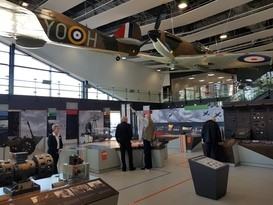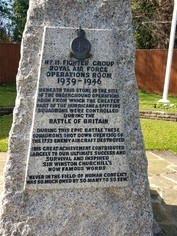We all arrived in our own cars at the Uxbridge Command Centre at 10 a.m. in good time for a coffee (and cake) in the new Visitor Centre cafe.
We then had time to look around the exhibits in the Centre. These included full scale, fully detailed replicas of a Spitfire and a Hurricane flying above a hall full of interesting items, from an air raid siren to a Merlin engine, an explanation of the new Radar system, and many other exhibits. The corridor leading into the main part of the hall was lined with graphics detailing the development of aerial warfare from airships to the Spitfire and beyond.
We were then led on a tour of the Command Centre itself. An inconspicuous grey concrete entrance went down into the earth to a series of rooms, 60 feet under a massive concrete slab designed to withstand a direct hit by the most powerful bombs then in existence.
From this room all the aerial combat in the South Eastern sector of England was directed against the invading Nazi bombers and fighters. The central plotting table, with its map of the South East and the Channel and the markers showing the positions of all the aircraft was laid out as it was on a day during the Battle of Britain in 1940. On the wall behind the was the system of lights showing the state of each squadron at the time – squadrons on the ground, refuelling, on standby, in the air and so on. We sat in the seats occupied by the personnel taking phoned-in information from observers and radar stations and passing it on to the women moving the markers on the table. The overall commander sitting in an office overlooking the hall could, at a glance, assess the situation of planes on the ground and in the air, and act accordingly.
Our very good guide took us through a typical day of combat in a most interesting and informative way.
 |  |
 |  |
 |  |
